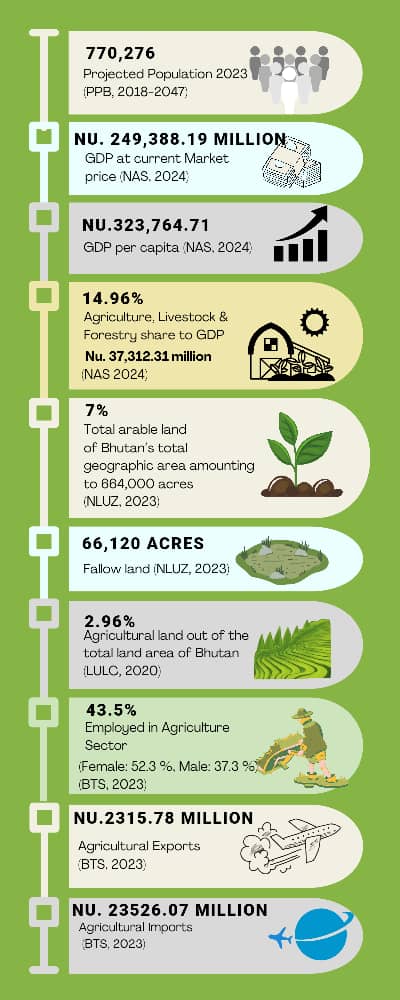Background
In 1961, the Department of Animal Husbandry (DoAH) was under the Ministry of Development (MoD). Based on the cadre system introduced by RCSC in the early 1980s, the Ministries and Departments were reorganized. As a result, the MoA was made responsible for forestry, agriculture, and animal husbandry. The DoAH was placed under the MoA in 1985 and was located near Trashichhodzong. In 1993, the Agricultural and Livestock Input Supplies and Farm Mechanization were combined together and merged with the DoAH, which was renamed as the Crop & Livestock Service Division (CLSD). In 1999 further reorganization continued and CLSD was renamed as Department of Agriculture & Livestock Support Services (DALSS). In early 2003, DALSS was bifurcated as the Department of Livestock (DoL).
Livestock plays an integral role in the lives of Bhutanese farmers. Large areas of the country can only be used for livestock production, while in other parts, livestock is an integral component of a deeply rooted farming system. In order to achieve the overall national objective of higher living standards for the Bhutanese population, rapid gains and high productivity is essential. This can be accelerated with a good organization structure whose institutions clearly defines and focuses on important aspects of efficient productivity under varied conditions.
Ever since the planned development started, Bhutan was critically short of skilled manpower. Even now Bhutan lacks skilled manpower in terms of quality and quantity. Through the development phase, there has been a replacement of expatriates who were assisting in many development roles, yet Bhutan has never reached a situation whereby there are enough for every need. Therefore, this exercise mainly focused on an approach towards meeting development needs based on the available capacity of established institutions. Accordingly, institutional setup for the department is re-organized with a priority towards achieving national objectives by boosting outputs from established institutions to achieve realistic results from the field with efficient delivery of services
Vision
To attain food-security and self-sufficiency in livestock products through enhanced rural livelihoods to alleviate poverty.
Mission
To increase livestock productivity by ensuring prompt delivery of appropriate technologies and services through commodity based approach.
Mandates
The mandates of the Department of Livestock are as follows:
- Develop sound policies and legal framework, strategies and guidelines to ensure efficient delivery of livestock services
- Mobilize resources and promote research and development
- Plan, coordinate, monitor, and evaluate the implementation of overall livestock development programs
- Build HR & Technical capacity of all programs
- Ensure the supply of quality livestock inputs
- Ensure sustainable utilization and management of livestock resources.
- Promote livestock enterprise development.
- Coordinate and implement a highland development program
- Promote climate resilient livestock production to mitigate and adapt to Climate Change.
- Promote organic livestock farming.
- Promote market access and marketing of livestock products.
- Facilitate formation of Farmer Groups, Cooperatives and Federations
- Safeguard health and welfare of animals through the provision of quality animal health services
- Promote one health approach to safeguard public health by prevention and control of zoonotic diseases
- Liaise with international and national stakeholders in areas of livestock development
Objectives
The objectives of the Department of Livestock are as follows:
- To enhance food and nutrition security and rural livelihood through the promotion of livestock farming
- To enhance the effective and efficient delivery of livestock services
- To generate appropriate technologies for enhancement of livestock production
- To encourage youths and public sector investment in livestock enterprises
- To promote sustainable management and utilization of Natural Resources and contribute to RNR sector growth
Divisions
Animal Health Division
Mandates
- To oversee policy formulation related to animal health program
- To mobilize resources and guide investment for animal health development
- To oversee HR performance, institutional and organization development
- To take lead in facilitating approval for animal health and veterinary service standards
Animal Nutrition Division
Mandates
- Oversee policy formulation related to animal nutrition
- Mobilize resources and guide investment for animal nutrition programs
- Oversee HR performance, institutional and organization development
- Approve animal feed production and product standards
- Promote relation with relevant national and international counterparts
Livestock Production Division
Mandates
- To oversee policy formulation on livestock inputs, production and development
- To mobilize resources and guide investment for input production and livestock development
- To oversee HR performance, institutional and organization development
- To take the lead in facilitating approvals for livestock production systems, and products Standards
Research & Extension Division
Mandate
- Formulate policies related to livestock research and extension;
- Function as technical authority to steer livestock research and extension programs;
- Coordinate, prioritize and set research agenda;
- Mobilize resources and build capacity to strengthen livestock research and extension; and
- Deliver research services with efficiency.
Please click the link for more details: dol.gov.bt
![]()



